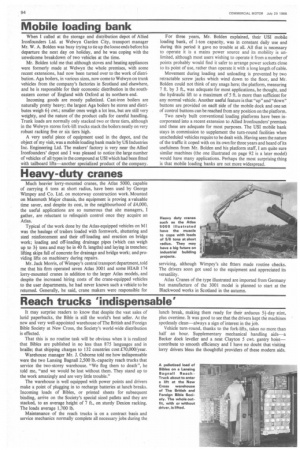Mobile loading bank
Page 96

If you've noticed an error in this article please click here to report it so we can fix it.
When 1 called at the storage and distribution depot of Allied Ironfounders Ltd. at Welwyn Garden City, transport manager Mr. W. A. Bolden was busy trying to tie up the loose ends before his departure the next day on holiday, and he was coping with the unwelcome breakdown of two vehicles at the time.
Mr. Bolden told me that although stoves and heating appliances were formerly made at Welwyn the whole premises, with some recent extensions, had now been turned over to the work of distribution. Aga boilers, in various sizes, now come to Welwyn on trunk vehicles from the company's factories in Scotland and elsewhere, and he is responsible for their economic distribution in the southeastern corner of England with Oxford at its northern end.
Incoming goods are mostly palletized. Cast-iron boilers are naturally pretty heavy; the largest Aga boilers he stores and distributes weigh 6+ cwt.; smaller ones weigh a lot less, but are still very weighty, and the nature of the product calls for careful handling. Trunk loads are normally only stacked two or three tiers, although in the Welwyn stores fork-lift trucks stack the boilers neatly on very robust racking five or six tiers high.
A very useful piece of equipment used in the depot, and the object of my visit, was a mobile loading bank made by US Industries Inc. Engineering Ltd. The makers' factory is very near the Allied Ironfounders' depot and I was pleased to notice the large number of vehicles of all types in the compound at USI which had been fitted with tailboard lifts—another specialized product of the company.
For three years, Mr. Bolden explained, their USI mobile loading bank, of 1-ton capacity, was in constant daily use and during this period it gave no trouble at all. All that is necessary to operate it is a mains power source and its mobility is unlimited, although most users wishing to operate it from a number of points probably would find it safer to arrange power sockets close to its point of use, rather than operate it with a long length of cable.
Movement during loading and unloading is prevented by two retractable screw jacks which wind down to the floor, and Mr. Bolden could not think of any snags here; the platform, measuring 7 ft. by 3 ft., was adequate for most applications, he thought, and the hydraulic lift to a maximum of 5 ft. is more than sufficient for any normal vehicle. Another useful feature is that "up" and "down" buttons are provided on each side of the mobile dock and one set of control buttons can be reached from any position on the platform.
Two newly built conventional loading platforms have been incorporated into a recent extension to Allied Ironfounders' premises and these are adequate for most purposes. The USI mobile bank stays in commission to supplement the turn-round facilities when unscheduled vehicles require to be dealt with. Having seen the nature of the traffic it coped with on its own for three years and heard of its usefulness from Mr. Bolden and his platform staff, I am quite sure similar machines (the one illustrated on page 92 is a later model) would have many applications. Perhaps the most surprising thing is that mobile loading banks are not more widespread.
































































































































































